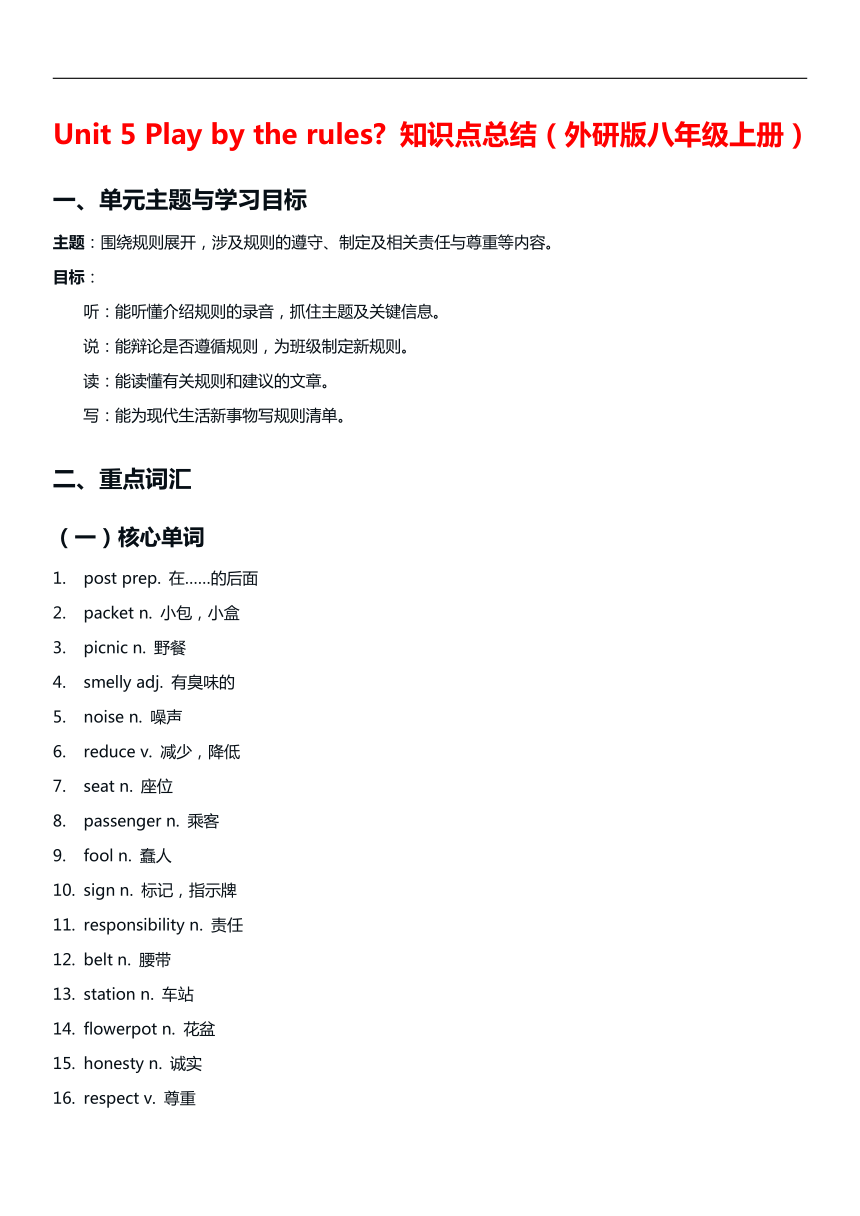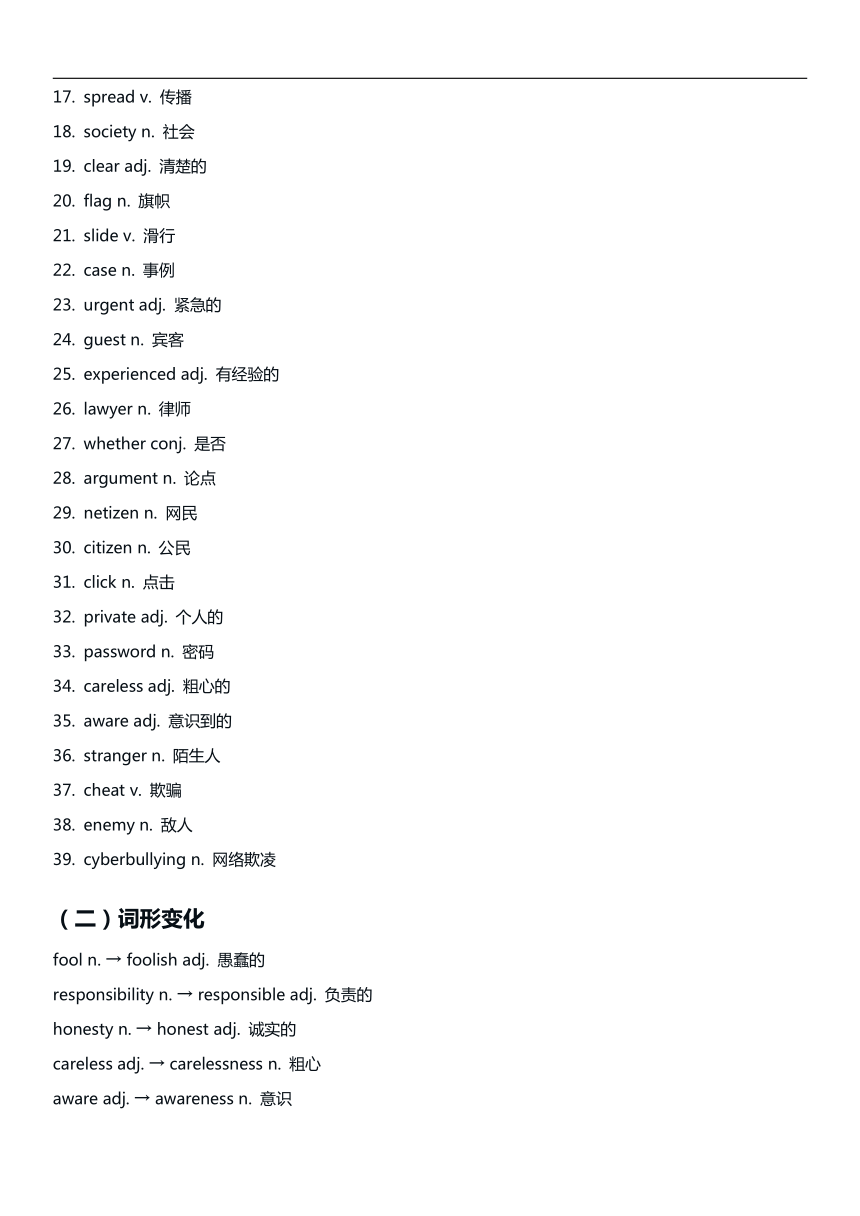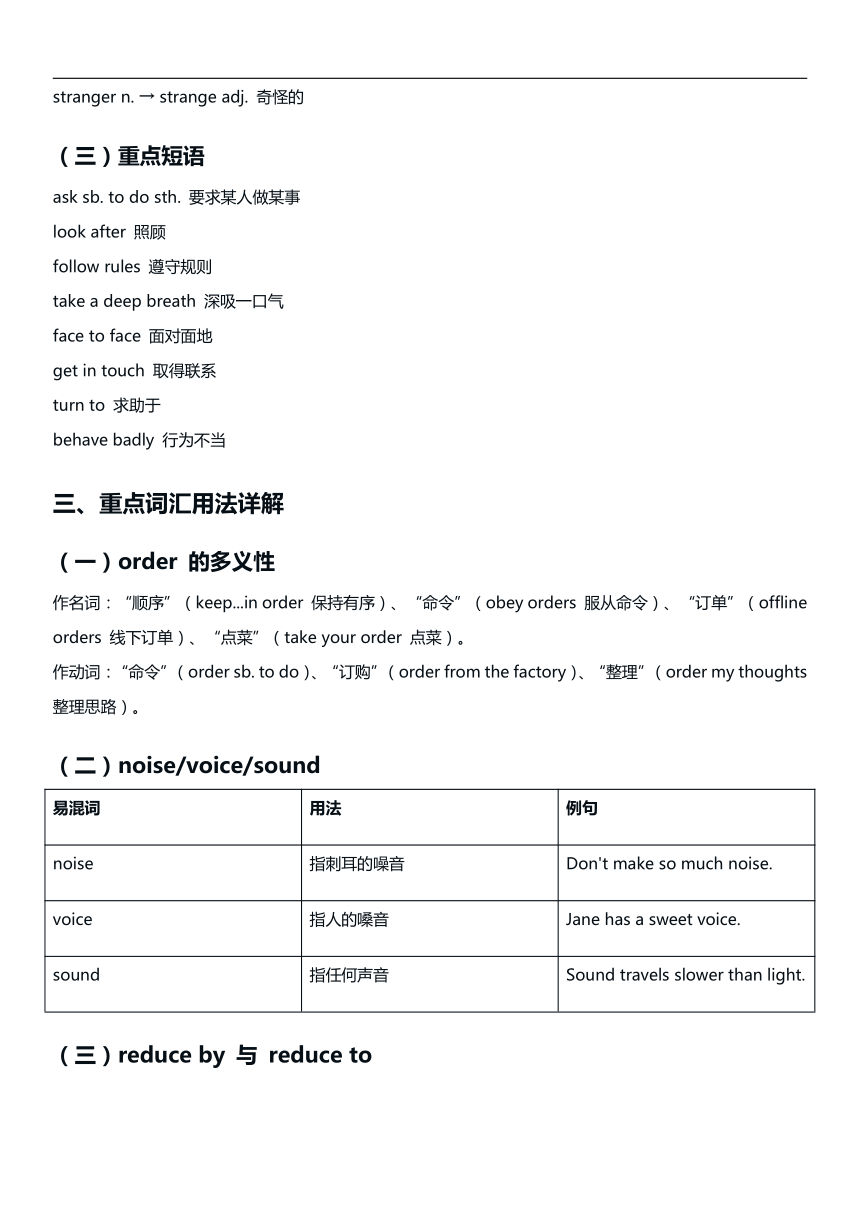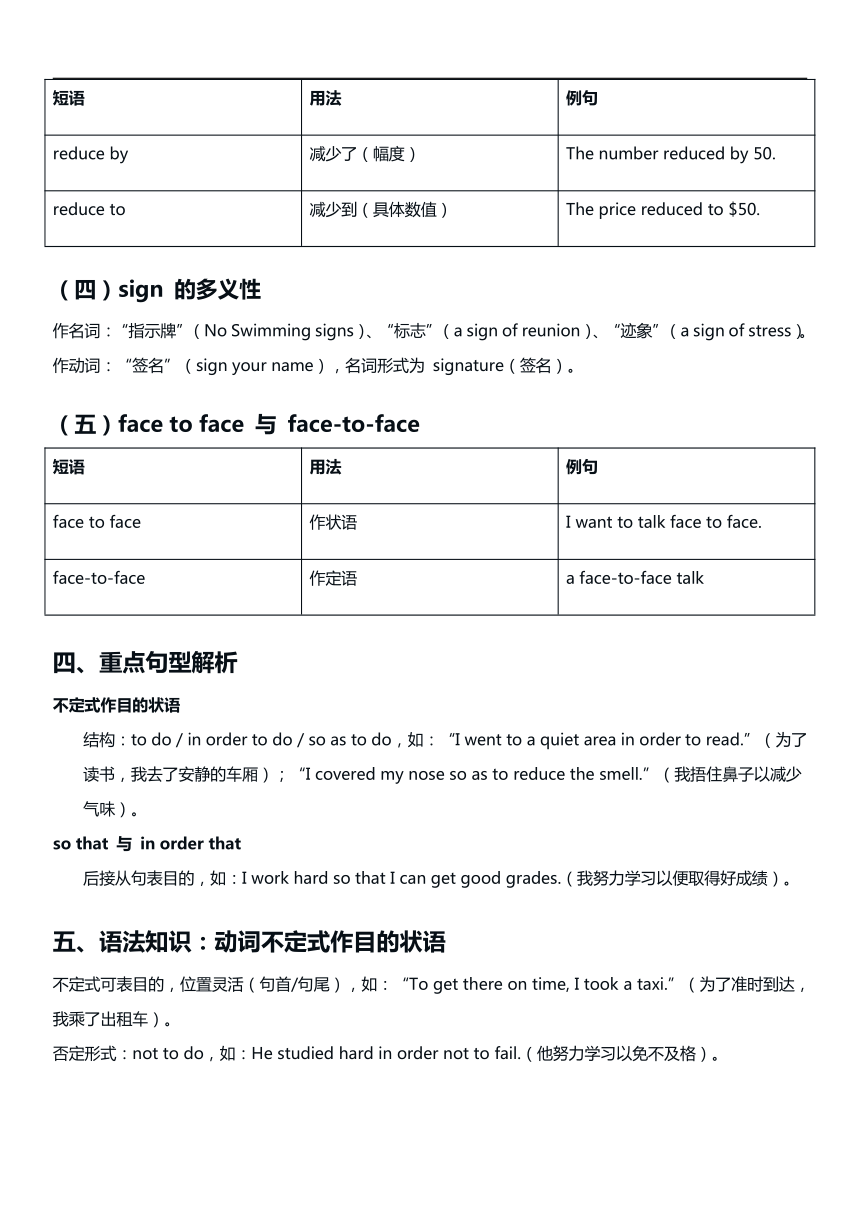Unit 5 Play by the rules知识点 外研版(2024)英语八年级上册
文档属性
| 名称 | Unit 5 Play by the rules知识点 外研版(2024)英语八年级上册 |  | |
| 格式 | docx | ||
| 文件大小 | 25.3KB | ||
| 资源类型 | 教案 | ||
| 版本资源 | 外研版 | ||
| 科目 | 英语 | ||
| 更新时间 | 2025-07-08 18:59:38 | ||
图片预览




文档简介
Unit 5 Play by the rules 知识点总结(外研版八年级上册)
一、单元主题与学习目标
主题:围绕规则展开,涉及规则的遵守、制定及相关责任与尊重等内容。
目标:
听:能听懂介绍规则的录音,抓住主题及关键信息。
说:能辩论是否遵循规则,为班级制定新规则。
读:能读懂有关规则和建议的文章。
写:能为现代生活新事物写规则清单。
二、重点词汇
(一)核心单词
post prep. 在……的后面
packet n. 小包,小盒
picnic n. 野餐
smelly adj. 有臭味的
noise n. 噪声
reduce v. 减少,降低
seat n. 座位
passenger n. 乘客
fool n. 蠢人
sign n. 标记,指示牌
responsibility n. 责任
belt n. 腰带
station n. 车站
flowerpot n. 花盆
honesty n. 诚实
respect v. 尊重
spread v. 传播
society n. 社会
clear adj. 清楚的
flag n. 旗帜
slide v. 滑行
case n. 事例
urgent adj. 紧急的
guest n. 宾客
experienced adj. 有经验的
lawyer n. 律师
whether conj. 是否
argument n. 论点
netizen n. 网民
citizen n. 公民
click n. 点击
private adj. 个人的
password n. 密码
careless adj. 粗心的
aware adj. 意识到的
stranger n. 陌生人
cheat v. 欺骗
enemy n. 敌人
cyberbullying n. 网络欺凌
(二)词形变化
fool n. → foolish adj. 愚蠢的
responsibility n. → responsible adj. 负责的
honesty n. → honest adj. 诚实的
careless adj. → carelessness n. 粗心
aware adj. → awareness n. 意识
stranger n. → strange adj. 奇怪的
(三)重点短语
ask sb. to do sth. 要求某人做某事
look after 照顾
follow rules 遵守规则
take a deep breath 深吸一口气
face to face 面对面地
get in touch 取得联系
turn to 求助于
behave badly 行为不当
三、重点词汇用法详解
(一)order 的多义性
作名词:“顺序”(keep...in order 保持有序)、“命令”(obey orders 服从命令)、“订单”(offline orders 线下订单)、“点菜”(take your order 点菜)。
作动词:“命令”(order sb. to do)、“订购”(order from the factory)、“整理”(order my thoughts 整理思路)。
(二)noise/voice/sound
易混词 用法 例句
noise 指刺耳的噪音 Don't make so much noise.
voice 指人的嗓音 Jane has a sweet voice.
sound 指任何声音 Sound travels slower than light.
(三)reduce by 与 reduce to
短语 用法 例句
reduce by 减少了(幅度) The number reduced by 50.
reduce to 减少到(具体数值) The price reduced to $50.
(四)sign 的多义性
作名词:“指示牌”(No Swimming signs)、“标志”(a sign of reunion)、“迹象”(a sign of stress)。
作动词:“签名”(sign your name),名词形式为 signature(签名)。
(五)face to face 与 face-to-face
短语 用法 例句
face to face 作状语 I want to talk face to face.
face-to-face 作定语 a face-to-face talk
四、重点句型解析
不定式作目的状语
结构:to do / in order to do / so as to do,如:“I went to a quiet area in order to read.”(为了读书,我去了安静的车厢);“I covered my nose so as to reduce the smell.”(我捂住鼻子以减少气味)。
so that 与 in order that
后接从句表目的,如:I work hard so that I can get good grades.(我努力学习以便取得好成绩)。
五、语法知识:动词不定式作目的状语
不定式可表目的,位置灵活(句首/句尾),如:“To get there on time, I took a taxi.”(为了准时到达,我乘了出租车)。
否定形式:not to do,如:He studied hard in order not to fail.(他努力学习以免不及格)。
六、易混词汇对比
(一)careless/careful
词 含义 例句
careless 粗心的 He made a careless mistake.
careful 小心的 Be careful with the vase.
(二)experienced/experience
词 词性 用法
experienced 形容词 He is experienced in teaching.
experience 名词 Traveling is a good experience.
七、教材原句解析
“I took a deep breath and stood up.”
解析:take a deep breath 表“深吸一口气”,体现克服紧张的动作。
“They set up fences and put up ‘No Swimming’ signs.”
解析:put up signs 表“张贴标志”,说明通过规则保护安全的方式。
八、学习策略与记忆技巧
主题关联记忆:将词汇与“规则”绑定,如:follow rules(遵守规则)、sign(指示牌)、responsibility(责任)。
词形变化串联:
名词变形容词:fool→foolish、honesty→honest。
形容词变名词:careless→carelessness、aware→awareness。
语法口诀:
“不定式,表目的,to do, in order to, so as to;
句首句尾皆可放,否定前加 not 记。”
短语对比:
look after(照顾)vs look for(寻找)
turn to(求助)vs turn on(打开)
语境运用:用“遵守规则”主题造句,如:We must follow traffic rules.(我们必须遵守交通规则)。
近义词辨析:通过例句区分 noise/voice/sound,如:The noise woke me up.(噪音吵醒我);She has a beautiful voice.(她嗓音优美)。
功能分类:将规则相关词汇归类,如:sign(标志)、rule(规则)、responsibility(责任),强化关联。
反义词配对:careless(粗心)→ careful(细心);private(私人的)→ public(公共的)。
介词搭配:记忆 responsible for(对……负责)、aware of(意识到)。
习语积累:take a deep breath(深吸气)、face to face(面对面)。
语法应用:刻意练习不定式作目的状语,如:To keep safe, we follow rules.(为了安全,我们遵守规则)。
场景联想:想到“禁止标志”时,联想 sign(指示牌)、no smoking(禁止吸烟)。
构词法记忆:掌握 -ment 后缀:argue→argument、develop→development。
词义拓展:了解 spread 既表“传播”也表“摊开”,如:spread news(传播消息)、spread papers(摊开文件)。
副词辨析:face to face(面对面)vs personally(亲自),通过语境区分。
句式转换:将不定式目的状语与 so that 转换,如:He studies hard to pass→He studies hard so that he can pass.
情感词汇:区分 foolish(愚蠢的)和 fool(傻瓜),如:It's foolish to be a fool.
实用短语:掌握 get in touch(取得联系)的用法,如:We can get in touch via phone.(我们可通过电话联系)。
九、核心词汇场景应用
(一)smelly 的构词与用法
由“smell(气味)+-y”构成,表“有臭味的”,如“smelly socks”(臭袜子)、“He had extremely smelly feet”(他的脚臭气熏天)。
其动词形式为 smell,可作“发臭”(不及物)或“闻到”(及物),如“The rubbish started to smell”(垃圾开始发臭)、“The dog smelt a rabbit”(狗嗅到了兔子)。
(二)responsibility 的搭配
常见短语“a sense of responsibility”(责任感)、“take responsibility for...”(对……负责),如“Parents have a responsibility to educate their children”(父母有教育孩子的责任)、“Each of us must take responsibility for our own actions”(我们每个人都要对自己的行为负责)。
(三)respect 的动词与名词用法
作动词:“His honesty made me respect him”(他的诚实让我尊重他)。
作名词:搭配“show respect for...”(对……表示尊重),如“We should show respect for the old”(我们应该尊重老人)。
十、短语辨析与拓展
(一)reduce by 与 reduce to 的具体应用
reduce by 强调减少的幅度,如“The company reduced the number of employees by 50”(公司减少了50名员工)。
reduce to 强调减少后的结果,如“The price was reduced to $50”(价格降到了50美元)。
(二)face to face 与 face-to-face 的用法差异
face to face 作状语,如“I want to talk with you face to face”(我想和你面对面谈)。
face-to-face 作定语,如“a face-to-face talk”(一次面对面的谈话)。
十一、语法难点突破
(一)动词不定式作目的状语的多种表达
常用结构:to do / in order to do / so as to do,如“To get there on time, I took a taxi”(为了准时到达,我乘了出租车);否定形式为“not to do”,如“He studied hard in order not to fail”(他努力学习以免不及格)。
可与“so that + 从句”转换,如“I work hard to get good grades = I work hard so that I can get good grades”(我努力学习以取得好成绩)。
十二、易混词对比强化
(一)noise/voice/sound 的细节区分
noise 指“噪音”,如“Don't make so much noise”(别那么吵)。
voice 指“人的嗓音”,如“Jane has a sweet voice”(简的嗓音很甜)。
sound 指“任何声音”,如“Sound travels slower than light”(声音比光传播得慢)。
(二)careless 与 careful 的反义应用
careless(粗心的):“He made a careless mistake”(他犯了个粗心的错误)。
careful(小心的):“Be careful with the vase”(小心那个花瓶)。
十三、教材原句深度解析
“I went to a quiet area in order to read.”
解析:in order to 引导目的状语,说明去安静区域的目的是“读书”,体现不定式表目的的用法。
“They set up fences and put up ‘No Swimming’ signs along the river.”
解析:put up signs 表示“张贴标志”,“No Swimming”是常见的规则类标志,体现规则的可视化形式。
十四、学习误区提醒
误:He reduced the price by 100 yuan.(×,若原价200元,此句表“减少了100元”,即现价100元,逻辑正确;若想表“降到100元”则应为 He reduced the price to 100 yuan.)
区分 reduce by(减少幅度)与 reduce to(减少到的结果)。
误:We should show respect to the old.(×)
正:We should show respect for the old.(√)(固定搭配 show respect for)。
十五、文化与学科链接
规则相关表达:
公共标识:No Smoking(禁止吸烟)、No Parking(禁止停车),对应文档中的“sign(指示牌)”用法。
社会责任:a sense of responsibility(责任感)、follow social rules(遵守社会规则),体现规则与社会的关联。
十六、高频考点链接
题目:She took a deep ______ and entered the room.
答案:breath(考查短语 take a deep breath)。
题目:We need to ______ the noise in the library.
A. reduce B. increase
答案:A(图书馆需“减少”噪音,reduce 符合语境)。
十七、记忆口诀汇总
(一)不定式作目的状语口诀
“不定式,表目的,to do 带头不迟疑;
in order to, so as to,句首句尾皆可居;
否定就在 to 前加 not,so that 从句也可以。”
(二)noise/voice/sound 辨析口诀
“noise 噪音使人烦,voice 嗓音属人言;
sound 泛指一切声,分类记忆不混乱。”
十八、记忆技巧补充
词根词缀串联:
名词变形容词:-y 后缀(smell→smelly、noise→noisy);-ful 后缀(care→careful)。
动词变名词:-ment 后缀(argue→argument、develop→development)。
场景归类记忆:
规则相关:sign(标志)、follow rules(遵守规则)、responsibility(责任)。
感官相关:smelly(臭味的)、noise(噪音)、sound(声音),集中记忆同一类别的词汇。
对比表格记忆:
制作 reduce by/reduce to、face to face/face-to-face 等对比表,标注用法和例句,直观区分差异。
一、单元主题与学习目标
主题:围绕规则展开,涉及规则的遵守、制定及相关责任与尊重等内容。
目标:
听:能听懂介绍规则的录音,抓住主题及关键信息。
说:能辩论是否遵循规则,为班级制定新规则。
读:能读懂有关规则和建议的文章。
写:能为现代生活新事物写规则清单。
二、重点词汇
(一)核心单词
post prep. 在……的后面
packet n. 小包,小盒
picnic n. 野餐
smelly adj. 有臭味的
noise n. 噪声
reduce v. 减少,降低
seat n. 座位
passenger n. 乘客
fool n. 蠢人
sign n. 标记,指示牌
responsibility n. 责任
belt n. 腰带
station n. 车站
flowerpot n. 花盆
honesty n. 诚实
respect v. 尊重
spread v. 传播
society n. 社会
clear adj. 清楚的
flag n. 旗帜
slide v. 滑行
case n. 事例
urgent adj. 紧急的
guest n. 宾客
experienced adj. 有经验的
lawyer n. 律师
whether conj. 是否
argument n. 论点
netizen n. 网民
citizen n. 公民
click n. 点击
private adj. 个人的
password n. 密码
careless adj. 粗心的
aware adj. 意识到的
stranger n. 陌生人
cheat v. 欺骗
enemy n. 敌人
cyberbullying n. 网络欺凌
(二)词形变化
fool n. → foolish adj. 愚蠢的
responsibility n. → responsible adj. 负责的
honesty n. → honest adj. 诚实的
careless adj. → carelessness n. 粗心
aware adj. → awareness n. 意识
stranger n. → strange adj. 奇怪的
(三)重点短语
ask sb. to do sth. 要求某人做某事
look after 照顾
follow rules 遵守规则
take a deep breath 深吸一口气
face to face 面对面地
get in touch 取得联系
turn to 求助于
behave badly 行为不当
三、重点词汇用法详解
(一)order 的多义性
作名词:“顺序”(keep...in order 保持有序)、“命令”(obey orders 服从命令)、“订单”(offline orders 线下订单)、“点菜”(take your order 点菜)。
作动词:“命令”(order sb. to do)、“订购”(order from the factory)、“整理”(order my thoughts 整理思路)。
(二)noise/voice/sound
易混词 用法 例句
noise 指刺耳的噪音 Don't make so much noise.
voice 指人的嗓音 Jane has a sweet voice.
sound 指任何声音 Sound travels slower than light.
(三)reduce by 与 reduce to
短语 用法 例句
reduce by 减少了(幅度) The number reduced by 50.
reduce to 减少到(具体数值) The price reduced to $50.
(四)sign 的多义性
作名词:“指示牌”(No Swimming signs)、“标志”(a sign of reunion)、“迹象”(a sign of stress)。
作动词:“签名”(sign your name),名词形式为 signature(签名)。
(五)face to face 与 face-to-face
短语 用法 例句
face to face 作状语 I want to talk face to face.
face-to-face 作定语 a face-to-face talk
四、重点句型解析
不定式作目的状语
结构:to do / in order to do / so as to do,如:“I went to a quiet area in order to read.”(为了读书,我去了安静的车厢);“I covered my nose so as to reduce the smell.”(我捂住鼻子以减少气味)。
so that 与 in order that
后接从句表目的,如:I work hard so that I can get good grades.(我努力学习以便取得好成绩)。
五、语法知识:动词不定式作目的状语
不定式可表目的,位置灵活(句首/句尾),如:“To get there on time, I took a taxi.”(为了准时到达,我乘了出租车)。
否定形式:not to do,如:He studied hard in order not to fail.(他努力学习以免不及格)。
六、易混词汇对比
(一)careless/careful
词 含义 例句
careless 粗心的 He made a careless mistake.
careful 小心的 Be careful with the vase.
(二)experienced/experience
词 词性 用法
experienced 形容词 He is experienced in teaching.
experience 名词 Traveling is a good experience.
七、教材原句解析
“I took a deep breath and stood up.”
解析:take a deep breath 表“深吸一口气”,体现克服紧张的动作。
“They set up fences and put up ‘No Swimming’ signs.”
解析:put up signs 表“张贴标志”,说明通过规则保护安全的方式。
八、学习策略与记忆技巧
主题关联记忆:将词汇与“规则”绑定,如:follow rules(遵守规则)、sign(指示牌)、responsibility(责任)。
词形变化串联:
名词变形容词:fool→foolish、honesty→honest。
形容词变名词:careless→carelessness、aware→awareness。
语法口诀:
“不定式,表目的,to do, in order to, so as to;
句首句尾皆可放,否定前加 not 记。”
短语对比:
look after(照顾)vs look for(寻找)
turn to(求助)vs turn on(打开)
语境运用:用“遵守规则”主题造句,如:We must follow traffic rules.(我们必须遵守交通规则)。
近义词辨析:通过例句区分 noise/voice/sound,如:The noise woke me up.(噪音吵醒我);She has a beautiful voice.(她嗓音优美)。
功能分类:将规则相关词汇归类,如:sign(标志)、rule(规则)、responsibility(责任),强化关联。
反义词配对:careless(粗心)→ careful(细心);private(私人的)→ public(公共的)。
介词搭配:记忆 responsible for(对……负责)、aware of(意识到)。
习语积累:take a deep breath(深吸气)、face to face(面对面)。
语法应用:刻意练习不定式作目的状语,如:To keep safe, we follow rules.(为了安全,我们遵守规则)。
场景联想:想到“禁止标志”时,联想 sign(指示牌)、no smoking(禁止吸烟)。
构词法记忆:掌握 -ment 后缀:argue→argument、develop→development。
词义拓展:了解 spread 既表“传播”也表“摊开”,如:spread news(传播消息)、spread papers(摊开文件)。
副词辨析:face to face(面对面)vs personally(亲自),通过语境区分。
句式转换:将不定式目的状语与 so that 转换,如:He studies hard to pass→He studies hard so that he can pass.
情感词汇:区分 foolish(愚蠢的)和 fool(傻瓜),如:It's foolish to be a fool.
实用短语:掌握 get in touch(取得联系)的用法,如:We can get in touch via phone.(我们可通过电话联系)。
九、核心词汇场景应用
(一)smelly 的构词与用法
由“smell(气味)+-y”构成,表“有臭味的”,如“smelly socks”(臭袜子)、“He had extremely smelly feet”(他的脚臭气熏天)。
其动词形式为 smell,可作“发臭”(不及物)或“闻到”(及物),如“The rubbish started to smell”(垃圾开始发臭)、“The dog smelt a rabbit”(狗嗅到了兔子)。
(二)responsibility 的搭配
常见短语“a sense of responsibility”(责任感)、“take responsibility for...”(对……负责),如“Parents have a responsibility to educate their children”(父母有教育孩子的责任)、“Each of us must take responsibility for our own actions”(我们每个人都要对自己的行为负责)。
(三)respect 的动词与名词用法
作动词:“His honesty made me respect him”(他的诚实让我尊重他)。
作名词:搭配“show respect for...”(对……表示尊重),如“We should show respect for the old”(我们应该尊重老人)。
十、短语辨析与拓展
(一)reduce by 与 reduce to 的具体应用
reduce by 强调减少的幅度,如“The company reduced the number of employees by 50”(公司减少了50名员工)。
reduce to 强调减少后的结果,如“The price was reduced to $50”(价格降到了50美元)。
(二)face to face 与 face-to-face 的用法差异
face to face 作状语,如“I want to talk with you face to face”(我想和你面对面谈)。
face-to-face 作定语,如“a face-to-face talk”(一次面对面的谈话)。
十一、语法难点突破
(一)动词不定式作目的状语的多种表达
常用结构:to do / in order to do / so as to do,如“To get there on time, I took a taxi”(为了准时到达,我乘了出租车);否定形式为“not to do”,如“He studied hard in order not to fail”(他努力学习以免不及格)。
可与“so that + 从句”转换,如“I work hard to get good grades = I work hard so that I can get good grades”(我努力学习以取得好成绩)。
十二、易混词对比强化
(一)noise/voice/sound 的细节区分
noise 指“噪音”,如“Don't make so much noise”(别那么吵)。
voice 指“人的嗓音”,如“Jane has a sweet voice”(简的嗓音很甜)。
sound 指“任何声音”,如“Sound travels slower than light”(声音比光传播得慢)。
(二)careless 与 careful 的反义应用
careless(粗心的):“He made a careless mistake”(他犯了个粗心的错误)。
careful(小心的):“Be careful with the vase”(小心那个花瓶)。
十三、教材原句深度解析
“I went to a quiet area in order to read.”
解析:in order to 引导目的状语,说明去安静区域的目的是“读书”,体现不定式表目的的用法。
“They set up fences and put up ‘No Swimming’ signs along the river.”
解析:put up signs 表示“张贴标志”,“No Swimming”是常见的规则类标志,体现规则的可视化形式。
十四、学习误区提醒
误:He reduced the price by 100 yuan.(×,若原价200元,此句表“减少了100元”,即现价100元,逻辑正确;若想表“降到100元”则应为 He reduced the price to 100 yuan.)
区分 reduce by(减少幅度)与 reduce to(减少到的结果)。
误:We should show respect to the old.(×)
正:We should show respect for the old.(√)(固定搭配 show respect for)。
十五、文化与学科链接
规则相关表达:
公共标识:No Smoking(禁止吸烟)、No Parking(禁止停车),对应文档中的“sign(指示牌)”用法。
社会责任:a sense of responsibility(责任感)、follow social rules(遵守社会规则),体现规则与社会的关联。
十六、高频考点链接
题目:She took a deep ______ and entered the room.
答案:breath(考查短语 take a deep breath)。
题目:We need to ______ the noise in the library.
A. reduce B. increase
答案:A(图书馆需“减少”噪音,reduce 符合语境)。
十七、记忆口诀汇总
(一)不定式作目的状语口诀
“不定式,表目的,to do 带头不迟疑;
in order to, so as to,句首句尾皆可居;
否定就在 to 前加 not,so that 从句也可以。”
(二)noise/voice/sound 辨析口诀
“noise 噪音使人烦,voice 嗓音属人言;
sound 泛指一切声,分类记忆不混乱。”
十八、记忆技巧补充
词根词缀串联:
名词变形容词:-y 后缀(smell→smelly、noise→noisy);-ful 后缀(care→careful)。
动词变名词:-ment 后缀(argue→argument、develop→development)。
场景归类记忆:
规则相关:sign(标志)、follow rules(遵守规则)、responsibility(责任)。
感官相关:smelly(臭味的)、noise(噪音)、sound(声音),集中记忆同一类别的词汇。
对比表格记忆:
制作 reduce by/reduce to、face to face/face-to-face 等对比表,标注用法和例句,直观区分差异。
同课章节目录
